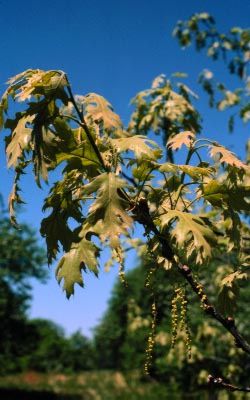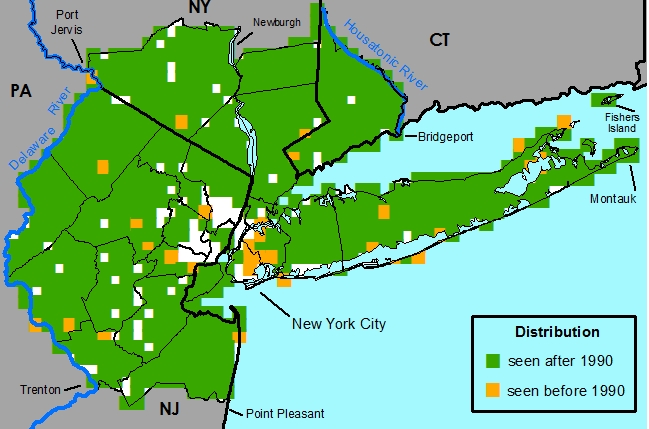Quercus velutina Lam. - Black Oak
Common Names
Black OakField Identification
Medium-sized to large deciduous tree with alternate, simple, lobed leaves; buds completely covered with hairs and clustered near twig ends; catkin-like flowers in spring followed by acorns in the fall. Acorns with loose brown-scaled caps.Food uses
Disclaimer: The information provided here is for reference and historical use. We do not recommend nor do we condone the use of this species for food purposes without first consulting a physician.
Native American often used the acorns for a variety of food products, usually by removing the tannins by boiling the nuts or soaking them in lye water. (Moerman, 1998)
Medicinal uses
Disclaimer: The information provided here is for reference and historical use. We do not recommend nor do we condone the use of this species for medicinal purposes without first consulting a physician.
Used by Native Americans to treat a variety of maladies including dysentery, mouth and skin sores, fevers, asthma, urinary disorders, "female trouble", and lung troubles. (Moerman, 1998)
Other uses
Oak-mast surveys may help wildlife agencies better understand dynamics of fall harvests and may be useful in harvest management models that attempt to stabilize fall harvest rates of game animals (Norman, 2003).Tannins derived from oaks have been used historically to tan animal hides into leather. (Burrows & Tyrl, 2001)
The Native Americans used the fiber for constructing baskets, wood for firewood as well as making tools and wigwams, leaves for wrapping dough in bread making, and the bark for preparing dyes. The wood was used by European settlers for making lumber, railroad ties, wagon wheels, and furniture. (Moerman, 1998)
Poisonous Properties
Oak leaves, buds, bark, and acorns contain tannins which have varying degrees of toxicity in different animals. Although oak foliage and acorns provide valuable food for many wildlife species and even some livestock, oak toxicosis, a urinary and digestive tract disease can occur when some animals are forced to subsist on oaks exclusively for several days. Poisoning is rare in humans due to the large amounts needed to ingest to cause symptoms. (Burrows & Tyrl, 2001)
Stories
Dryads or "tree spirits" are nymphs associated with Greek mythology which live near, or in, trees. Dryads are born bonded to a specific tree, originally, in the Indo-European Celtic-Druidic culture, an oak tree. Drys in Greek signifies 'oak,' from an Indo-European root *derew(o)- 'tree' or 'wood.' In the primitive times, the Greeks imagined, people were able to live on acorns.
In a nationwide vote hosted by the National Arbor Day Foundation in 2001, the oak was selected as America's National Tree.
Nomenclature
Quercus velutina Lam., Encycl. Meth. Bot. 1: 721. 1785.Quercus nigra sensu Du Roi, Harbk. Baumz. 2: 272, pl. 6, fig. 1. 1772, not L. 1753.
Quercus discolor Ait., Hort. Kew. 3: 358. 1789.
Quercus tinctoria Bartr., Travels N. & S. Carol. 37. 1791.
Quercus tintoria var. angulosa Michx., Fl. Bor.-Am. 198. 1803.
Quercus tintoria var. sinuosa Michx., Fl. Bor.-Am. 198. 1803.
Quercus coccinea var. nigrescens A. de Cand., Prodr. 16,2: 61. 1864.
Quercus coccinea var. tinctoria A. de Cand., Prodr. 16,2: 61. 1864.
TYPE: unknown
Description
HABIT Perennial, deciduous, phanerophytic, tree, diclinous and monoecious, 25-30 m tall.
STEMS Main stems ascending or erect, round. Bark tightly and irregularly fissured with scaly ridges, gray or dark gray, not exfoliating. Branches erect or ascending or horizontal. Twigs fluted-terete, 2-5 mm in diameter, smooth and lenticellate, dark reddish-brown and sparsely to heavily covered with brown fasciculate hairs on 1st year twigs, gray to brown and glabrous on older twigs. Pith white, 5-pointed, continuous, nodal diaphragm absent. Sap translucent. For an anatomical study of the xylem see Tillson & Muller, 1942.
BUDS Terminal and axillary present, clustered at twig apices and scattered along stem, usually densely brown or gray hairy for most of their length. Terminal bud ovoid, blunt to semi-pointed; axillary buds ovoid, blunt to semi-pointed. Bud scales dark brown or brown, imbricate, with short and unbranched appressed brown or light brown to gray hairs, moderately densely to densely distributed. Bud scale scars encircling the twig. Leaf scars crescent-shaped. Vascular bundle scars numerous, scattered.
LEAVES Alternate, simple, (appearing pseudo-opposite or pseudo-whorled at twig apices), crowded toward stem apex or spaced somewhat evenly along and divergent from stem. Stipules lateral, free from the petiole, linear, caducous. Petiole adaxially flattened, 1-6 cm long, with brown to light brown fasciculate erect to spreading hairs, moderately densely or densely distributed throughout (rarely glabrous?). Leaf blades: abaxial surface light green to yellow-green, sometimes glossy; adaxial surface green to dark green, often glossy; elliptic or ovate or obovate, bilaterally symmetric, 6-26 cm long, 4.5-24 cm wide, chartaceous; base obtuse or truncate or cuneate; margins somewhat symmetrically 3-5 lobed per side (1/8)1/4 - 3/4 distance to the midvein with rounded sinuses and acute or obtuse, aristate apices; apex acute or obtuse and aristate. Exhibits some of the most plasticity of any oak (Ashton & Berlyn, 1994); (& personal observations). Abaxial surface obscurely papillose and can exhibit the following hair types: a. fasciculate brown to light brown to almost white erect to spreading hairs, moderately to densely distributed throughout, but especially along the midvein; b. simple brown to light brown to almost white erect hairs , sparsely to moderately distributed mainly along the main vein; c. minute simple yellowish more or less appressed multi-cellular glandular hairs, sparsely to densely distributed throughout; d. tufted multi-radiate brown to light brown to almost white hairs sparsely to moderately distributed throughout. Adaxial surface with all aforementioned hair types when young, retaining only sparsely scattered (often concentrated along veins) multi-radiate hairs when mature; see Hardin, 1979a;Thompson & Mohlenbrock, 1979; and for an overview of the phenology and the variability and density of hairs due to ecological factors and hybridization see Hardin, 1979b. For an anatomical/morphological studies of the stomata, cuticle, epidermis, mesophyll and leaf shape in relation to different light environments see Ashton & Berlyn, 1994 and Osborn & Taylor, 1990.
FEMALE INFLORESCENCES Coetaneous, spike consisting of a single flower (sometimes 2-3), in axils of current year leaves, subsessile initially, often becoming short-pedunculate in fruit, surrounded by a cupule which is persistent, accrescent, and indurate in fruit (acorn cap). There has been debate over the years regarding the true ontogenetic nature of the cupule. Originally thought to be an involucre of bracts, recent research suggests that the cupule is a complex partial inflorescence derived from stem tissue, see Abbe, 1974;Brett, 1964;Foreman, 1966;MacDonald, 1979;Fey & Endress, 1983. Each cupule subtended by 3 minute, caducous bracteoles.
FEMALE FLOWERS Perianth of one whorl, minute, fragrance absent. Calyx urceolate, of fused sepals. Carpels 3. Locules 3, each containing 2 ovules. Styles 3, each with 1 stigma. Ovary inferior. Placentation axile. For an anatomical review of embryogenesis see Conrad, 1900.
MALE INFLORESCENCES Coetaneous, compound, solitary or fascicled spikes; pendant, catkin-like; in leaf axils of previous year. Rachis moderately to densely covered with brown to white hairs; elongating and glabrescent with age; with 1 subsessile or sessile flower per node, each flower subtended by a small, sessile caducous bracteole.
MALE FLOWERS Perianth of one whorl, 3.5-4 mm in diameter, fragrance absent. Calyx actinomorphic, campanulate, of fused sepals. Sepal lobes 2-3, broadly oval to ovate with brown to white hairs moderately dense along margins. Stamens 4-5, exserted. Anthers glabrous, basifixed, opening along the long axis. Filaments free, 1mm long, straight, glabrous (Rowlee & Nichols, 1900). For a review of pollen morphology see Solomon, 1983a. For an anatomical review of microsporogenesis see Conrad, 1900.
FRUITS Acorn (glans (Spjut, 1994)) (calybium (Kaul, 1985)) sessile to short-pedunculate; maturation biennial. Acorn ovoid-subglobose, 1.5-2 cm long, comprised of 2 parts- a. the crateriform-turbinate cup (cupule), enclosing 1/2 of the base of the nut; and b. the nut, 1-seeded by abortion (rarely 2-3 (Hosner, 1959); (Coker, 1904)). For a hypothesis that the first ovule fertilized suppresses the normal development of the others see Mogensen, 1975. Cupule exterior composed of imbricate, moderately to loosely appressed scales moderately covered with brown tomentum. Nut olive-green to brown, ovoid-subglobose, with large light-colored circular cupule scar at base and apiculate at the distal end, minutely laterally striate; initially with minute short and unbranched appressed brown to light brown hairs, sparsely or moderately densely distributed throughout, glabrescent. One study found a size range of 0.42-3.60 cubic cm with a mean of 1.40 cubic cm and a correlation between smaller acorn size with increasing latitude see Aizen & Woodcock, 1992.
SEEDS Embryo with two large fleshy cotyledons, endosperm lacking. (Young & Young, 1992).
Habitat
Usually occurring in mesic to dry well drained substrates of barrens, woods, slopes, ridges, and roadsides.Distribution
Indigenous to eastern North America.United States -- AL, AR, CT, DC, DE, FL, GA, IA, IL, IN, KS, KY, LA, MA, MD, ME, MI, MN, MO, MS, NC, NE, NH, NJ, NY, OH, OK, PA, RI, SC, TN, TX, VA, VT, WI, WV
Canada -- ON
New York Metropolitan Region -- Native throughout the metropolitan region.
Rarity Status
Global Heritage Rank -- G5Connecticut -- Not listed
New Jersey -- Not listed
New York -- Not listed
Species Biology
Flowering May [week 1] - June [week 1]
Pollination Anemophily
Fruiting August [week 1] - October [week 4]
Often masting, for an investigation on the effects of weather on acorn yields see Sharp & Sprague, 1967. For a study suggesting that masting is effected by weather in conjunction with inherent reproductive cycles see Sork, et al., 1993.
Dispersal Small predators of acorns facilitate dispersal by dropping undamaged nuts and failing to recover cached nuts. These include Sciurus carolinensis (gray squirrel), Sciurus niger (fox squirrel), Glaucomys volans (southern flying squirrel), Tamias striatus (eastern chipmunk), Peromyscus leucopus (white-footed mouse), Peromyscus maniculatus (deer mouse) and Quiscalus quiscula (common grackle) and Cyanocita cristata (blue jay). (Ivan & Swihart, 2000) (Smith, 1972) (Briggs & Smith, 1989) (Wolff, 1996) (Bosema, 1979) (Darley-Hill & Johnson, 1981) (Johnson & Webb, 1989) (Johnson, et al., 1993)
In addition, one study found that many predators preferred the basal end of the acorn and consumed only 30-60% of the cotyledon. A chemical analyses of acorns from two species revealed that the concentration of protein- precipitable phenolics (primarily tannins) was 12.5% (Q. phellos) and 84.2% (Q. laevis) higher in the apical portion of the seeds where the embryo is located, suggesting that many acorn consumers consistently eat only a portion of the cotyledon of several species of acorns and thereby permit embryo survival. (Steele, et al., 1993).
Probably included in the diet of the Urocyon cinereoargenteus (grey fox) (Scott, 1955), Meleagris gallopavo silvestris (eastern wild turkey) (Norman, 2003), and Odocoileus virginianus (white-tailed deer) (Bryant, et al., 1996).
Germination (Young & Young, 1992) (Schopmeyer, 1974) Acorns of members of the black/red oak group have embryo dormancy and germinate naturally the following spring, germination is hypogeal. Moist stratification for 30-90 days at 1-5 d C can be used to break dormancy. For germination to occur the moisture content of the acorns must not drop below 20-30%. It is usually impossible to store acorns for more than 6 months.
In one study (Q. phellos and Q. laevis), germination experiments revealed equal or greater germination frequencies
for partially consumed acorns than for intact acorns. (Steele, et al., 1993).
For a propagation protocol for growing bareroot oaks see Hoss, 2004.

